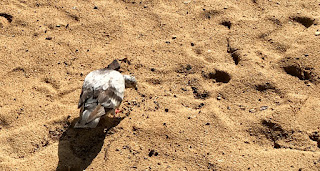The Hanauma Bay Nature Preserve is no more. Welcome to the Hanauma Bay Exotic Animal Park.
 |
| Hanauma Bay |
First, there are a number of histories of Hanauma Bay that are relevant here:
1. Coral Reef Assessment and Monitoring Program, Hanauma Bay Study Site.
2. City and County of Honolulu, Hanauma Bay History (I think much of this came from one of John Hoover's books). There is a visual timeline associated with this website.
3. Wikipedia, Hanauma Bay.
It is my understanding that, "Today the City and County of Honolulu administers that part of Hanauma Bay Nature Preserve lying above the high tide line, and the State of Hawai'i Dept. of Land and Natural Resources manages the underwater portion" (City and County of Honolulu).
That underwater portion and the portion below the high tide line? That is the Hanauma Bay Marine Life Conservation District, designated as the first MLCD in 1967. The Hanauma Bay Marine Life Conservation District recently celebrated its 50th anniversary. A number of my friends, like Alan Hong, Jeff Kuwabara, Jennifer Barrett, Bob Kern, and Micki Stash (and others) worked very hard to protect the bay and its inhabitants.
 |
| Map delineating the MLCD boundary for Hanauma Bay. |
A "nature preserve" (or "reserve") is defined as "an area of land protected... so that plants and animals can live there without being harmed." I'm not a plant specialist, so I can't say much about the flora (although there is a mix of native and exotic plants). However, here are photos of the primary animal life today:
Get the picture? I observed 18 cats today, some feral, others clearly socialized. Many visitors gravitated to the cats (which were begging to be fed). The mongoose seemed out of control. I watched 4 mongoose go into visitors' bags and pull out whole containers of food. The mongoose crawl in and out of every garbage can on the beach. "What is that long rodent-like animal?" is becoming one of the most commonly asked questions to the volunteer staff. And then there are the chickens and roosters, and the pigeons. So where is the "area of land protected... so that plants and animals can live there without being harmed"?
I submit that the combination of cats, mongoose, pigeons, and chickens, acting as predators, food or space competitors, or disease vectors or reservoirs, probably affect the ability of native species to persist in this "Nature Preserve." There are exotic mynahs and zebra doves. I haven't seen them, but I am certain there are also introduced rats and mice. There is limited enforcement of any type of feeding ban, unlike the ban on feeding fish in the bay (the fish feeding ban had obvious impacts on the composition of fish in the inner reef, and is emphasized in the mandatory video).
The Hanauma Bay Nature Preserve is no more. Welcome to the Hanauma Bay Exotic Animal Park.














STOP feedign feral cats there BAN it toxoplasmosis, and trap the mongoose. Ban feeding like they did for the fish
ReplyDeleteThis seems to be an effective kill trap for mongoose: goo.gl/RSKCo3
DeleteIf cats are left in place, some people will feel compelled to feed them, tourists and locals alike. I think that unowned cats have to be removed continuously and humanely euthanised. Some people feel compelled to keep all cats alive and avoid euthanasia. There is no reasoning with them. A compromise with them might be they take full responsibility for the cats and install a kittyfence that can contain cats (many designs available) or catio on their own property. Cats in this situation are not only a wildlife issue, but a public health issue, causing visceral and ocular larval migrans (Toxocara catii), toxoplasmosis (Toxoplasma gondii), fleas, gastroenteritis (Cryptosporidium, Giardia, Helicobacter, Campylobacter), cat scratch fever (bartonella spp) and the list goes on. As to mongoose, why not remove them, since they harm local species? And chickens, really? People eat chickens, nothing sacred about them.
ReplyDeleteDitto, killing works. Here on the East Side of Hawai'i Island we trap and kill often.
DeleteAs I understand it, by either law or policy, microchipped cats must be returned to their "owners" (I'm guessing that at least half of the cats at HB are microchipped). These owners will probably return the cat to Hanauma Bay.
ReplyDeleteThere are some interesting trials on a new kill trap for mongoose: goo.gl/RSKCo3.
Hopefully the cats think like mongoose.
Deletelooool
ReplyDelete